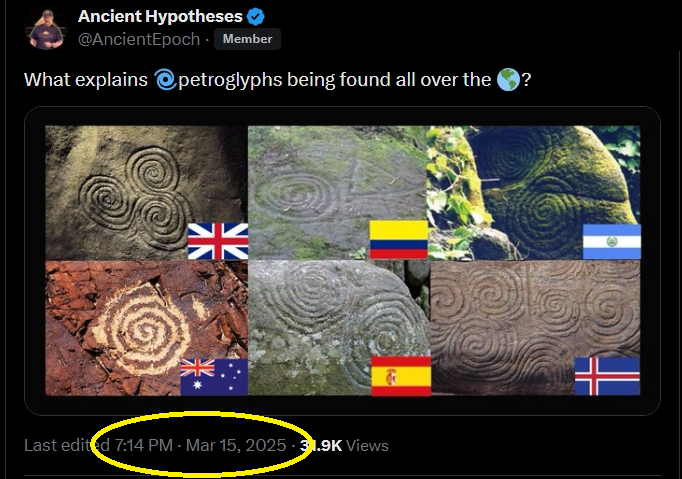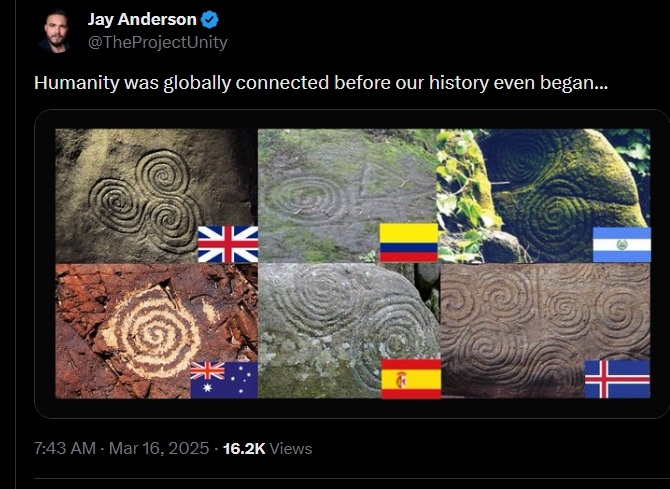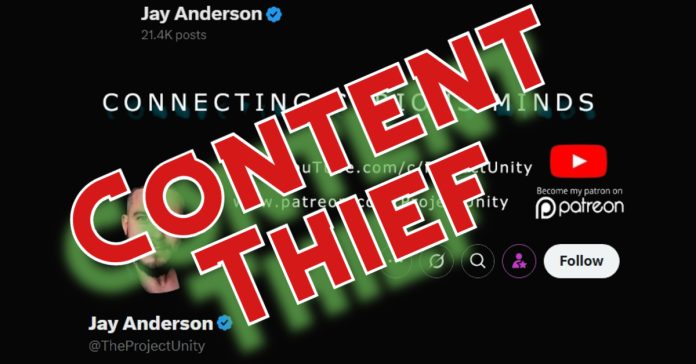Jay Anderson, the voice of Project Unity, has carved a niche on X, 40K followers, blue check, a torrent of posts blending UFOs, AI, and ancient mysteries. He’s got a knack for grabbing eyeballs, but peek under the hood, and the engine’s running on borrowed parts and hot air. Here’s how his operation, content thievery, flimsy claims, and X ad cash, leaves a whiff of disingenuousness that’s hard to ignore.
The Image Grab: Lifting Without Credit

Anderson’s X feed (@TheProjectUnity) is a gallery of repurposed visuals, Egyptian carvings, Sumerian tablets, odd artifacts. He snags pics from other X users or the web, often without a nod to the source. A sphinx shot might land with “ancient tech proof?”, no “via @user” or link. Scroll his posts, and uncredited screenshots pile up—cave art, old manuscripts, random relics. Replies call it out “where’s this from?” but he shrugs it off. It’s not illegal; X’s fair use is lax. But when you’re pocketing ad revenue off someone else’s snap, the ethics get murky fast.

Loose Claims, Boring Flavor
His ancient history takes are a yawn; recycled fringe bait with no meat. Pyramids as power plants? Vimanas as spacecraft? He’ll toss out “lost tech” musings, like “Sanskrit hides flight secrets”, without a shred of evidence. Linguists say vimanas are metaphors, not machines; engineers find no power conduits in pyramid stone. It’s not deep theory, just lazy, oft-debunked speculation, served up quick for likes. He’s not wrong enough to debunk hard, just dull enough to coast on mystery. Quantity over quality—10–20 posts daily keep the algorithm humming.
Profiting Nicely, Thanks to X
X’s Creator Ads Revenue Sharing pays for impressions from verified replies—$1–$10 per 1,000, say industry estimates. With 40K followers and relentless posting, Anderson’s likely hitting 50K–200K impressions monthly. Not riches, but tidy for a guy reposting pics and riffing on ancient “woo”. The platform boosts him, engagement’s his fuel, and every uncredited image or flimsy claim feeds the cash flow. He’s not hawking books or courses, but X’s ad machine doesn’t care about truth or originality; it pays for eyes.
The Disingenuous Drift
Tie it together: he lifts content, skips credit, spins shaky narratives, and cashes in, all while playing curious everyman. Fraud? Not in the lock-him-up sense—no Ponzi schemes here. But where profit hinges on pilfered pics and half-baked history, the sincerity frays. He’s not building knowledge; he’s farming clicks. The “I’m just asking questions” shtick feels hollow when X’s algorithm and ad dollars prop it up. You don’t need a scam to smell opportunism, stealing others’ work to pad your wallet’s enough.
Conclusion: A Hustle That Doesn’t Hold Up
Anderson’s Project Unity on X, isn’t a grand con, it’s a petty one. Snagging images, peddling tired ancient tropes, and riding the ad-revenue wave might not break rules, but it bends trust. When there’s profit in loose claims and light fingers, the vibe shifts from seeker to grifter. This alchemy turns content into cash, but it’s a formula that stinks of convenience over substance.

